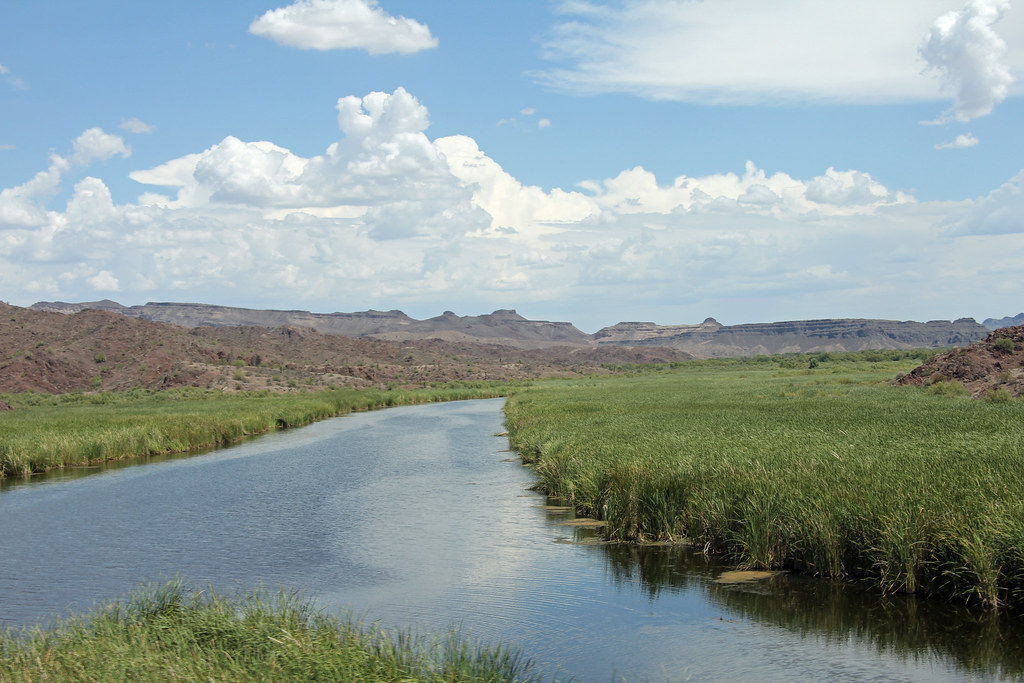Peering at a random spot on a map — one of my favorite hobbies — showed a river with a name so ordinary it seemed unusual. I realize that’s an oxymoron so bear with me a little while and hear me out.
Rivers often carry the names of the topography that surrounds it. Sometimes it’s in the language of a long-gone indigenous population, or maybe even the name of a famous nearby resident. However this one had a name that seemed like Average Joe or even Dude. It carries the rather generic moniker, Bill Williams River. That was my original (and as usual) completely incorrect thought. I discovered that Bill Williams was actually a rather interesting man. Unfortunately history largely forgot this remarkable figure and that’s a shame.
The River

The Bill Williams River (map) takes a short 36-mile jaunt through western Arizona. It stretches from Alamo Lake to Lake Havasu on the California border. Some of this journey traverses the aptly-named Bill Williams National Wildlife Refuge managed by the U.S. Fish and Wildlife Service. It’s an extremely remote and inhospitable Mojave Desert area with few amenities and even fewer roads. The American Whitewater website described it in stark terms:
“The run will be long and slow, probably taking 2 full days, and possibly more… This is a scenic desert adventure for strong-willed and strong-bodied boaters who really like to get away from crowded rivers. This one will NOT be inundated with throngs of paddlers! The most significant hazards on the Bill Williams River are desert temperatures, scorching sun, cactus, rattlesnakes, Gila monsters, hot desert sand, hot desert winds and a vast remoteness that has paddlers a long way from any type of services. Mountains along the riverbanks make cellular communications next to impossible, if possible at all… Personally, I would have my .44 Mag with me on a trip in this area – one never knows what he or she might encounter in the desert wilderness of western Arizona.”
The Man
What type of rugged individual would inspire such a remote and seemingly inhospitable place?
William Sherley Williams — who at least had the good sense to go by Bill Williams instead of William Williams, or Sherley for that matter — was one of the classic mountain men of the old west. He doesn’t have the same name recognition as some of his contemporaries like Kit Carson or John C. Frémont. However, he was a legend of a similar magnitude on that same frontier. He traversed those vast empty voids, got into various adventures and found ways to survive.
The definitive biography, and in fact the only book-length biography of him ever written, is “Old Bill Williams, Mountain Man,” by Alpheus Favour. Publishers have reprinted it several times since its first edition in 1936. Actually it’s still available on Amazon and from other sources even after all these years. That shows Bill Williams has some staying power with students of this era. Nonetheless, he lacks a wider name recognition in popular culture.
An Adventurous Life
Bill Williams was born in North Carolina in 1787. But his family relocated to the Missouri frontier when he was still quite young. As an adult he turned his back on civilization to become a master fur trapper, a preacher, a guide and an explorer. He befriended and battled many Native American tribes as he wandered through the Rockies, Desert Southwest and California. His mastery of numerous Indian languages made him extremely valuable. Both the U.S. military and tribal nations depended on him as they negotiated various treaties.
Then Williams agreed to guide Frémont’s fourth expedition through the southern Rockies in 1848. However, he pulled out when he deemed a wintertime crossing too dangerous. Frémont continued with disastrous results and blamed Williams, who historians have largely exonerated. Old Bill Williams died the next year in an attack led by Ute Indians as he was retracing the steps of the failed expedition. He lived 62 years. That’s nearly ancient for those who survived by their wits on the frontier during that era. He was a very solitary man and perhaps that is why he’s not as well remembered as some of the more iconic mountain men.
A Town and a Mountain
However, the people of the time held him in high regard. They imprinted his name upon the geography of the old west, particularly in Arizona. I first found the river but there are other places memorializing him.
His name lives on in Williams, Arizona, west of Flagstaff. This is a fairly sizable town for this sparsely-populated terrain, with nearly 3,000 inhabitants. Two items in particular make it noteworthy:
- The Grand Canyon Railway begins in Williams on its route to Grand Canyon Village. One town nickname is the Gateway to the Grand Canyon.
- Route 66, the fabled Mother Road, lasted longer in Williams than in any other place along its entire length between Chicago and Los Angeles. An interstate highway didn’t bypass it until 1984. That’s at least a decade or more longer than the norm.
More evidence of Bill Williams also exists just outside of town at a mountain named in his honor.
Something More Obscure
The smallest tribute I could find and actually see on a map occurs southeast of Tucson.
The Bill Williams Tank is a small reservoir in the middle of the desert. I imagine that it would be a nameless feature if it was located just about anywhere else. However, standing water is a rarity in this location and that makes it noteworthy. I can’t determine from the map how it’s used, and the Intertubes doesn’t help either. Only junk websites stuffed with advertising mentioned it. Maybe it’s for ranching? Maybe someone in the 12MC audience has a better clue?
I enjoyed discovering the legacy of Old Bill Williams and guess there’s still a little mystery left.

Leave a Reply